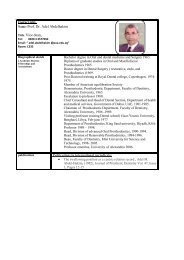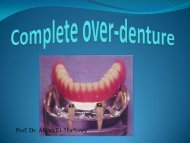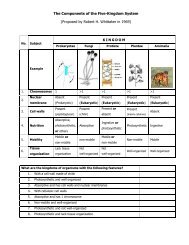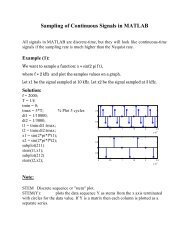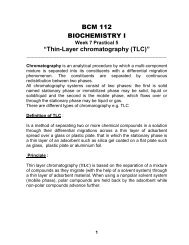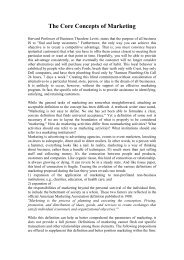Create successful ePaper yourself
Turn your PDF publications into a flip-book with our unique Google optimized e-Paper software.
<strong>TITRATION</strong> <strong>CURVES</strong><br />
I- STRONG ACID vs STRONG BASE :<br />
50 mL of 0.05 M HCl wth 0.1 M NaOH<br />
- Initial [H 3 O + ] = 0.05 pH = 1.3<br />
- with 10 mL NaOH<br />
[H 3 O + ] = [50 x 0.05 – 10 x 0.1]/60 = 2.5 x 10 -2 pH = 1.6<br />
- with 25 mL NaOH (Equivalence)<br />
[H 3 O + ] = [OH - ] = Kw = 1.0 x 10 -7 pH = 7.0<br />
- with 25.1 mL NaOH<br />
[H 3 O + ] = [25.1 x 0.1– 50 x 0.05]/75.1 = 1.33 x 10 -4 pH = 10.12<br />
Remark : The break interval of dil solutions is less than that of conc.<br />
solutions. While in conc. solutions MO, ph ph & BTB give the same e.p.;<br />
in dilute solution only BTB is appropriate.<br />
II- WEAK ACID vs STRONG BASE<br />
Equations Governing a weak acid (HA) Titration<br />
Fraction (F)<br />
titrated<br />
Present<br />
Equation<br />
F = O HA [H + ] = Ka . Ca<br />
O < F < 1 HA / A - [A - ]<br />
pH = pKa + log ________<br />
[HA]<br />
F = 1 A - Kw<br />
[OH - ] =<br />
______ .Cs<br />
Ka<br />
F > 1 OH - / A - [OH - ] = [Excess Titrant]<br />
• 50 mL 0.1 M HA (Ka = 1.75 x 10 -5 ) with 0.1 M NaOH<br />
- Initial [H 3 O + ] = Ka . Ca = 1.75 x 10 -5 x 0.1 = pH = 2.88<br />
- with 10 mL 0.1 M NaOH<br />
Cs (10 x 0.1)/60<br />
pH = pKa + log _____ = 4.76 + log ____________________________ pH = 4.16<br />
Ca (50 x 0.1- 10 x 0.1)/60<br />
- with 25 mL 0.1 M NaOH; half neutralization.<br />
1
pH = pka pH = 4.76<br />
- At equivalence point<br />
All acid is converted to acetate<br />
Kw 10 -14 50x0.1<br />
[OH - ] = _____ ____________<br />
.Cs =<br />
___________ = 5 x 10 -6 pH = 8.73<br />
Ka 1.7x10 -5 100<br />
- with 50.1 mL NaOH<br />
0.1 x 0.1<br />
[OH - ] = _________________ = 1.0 x 10 -4 pH = 10.00<br />
100.1<br />
III- WEAK BASE vs STRONG ACID<br />
Equations Governing a weak base (B) Titration<br />
Fraction (F)<br />
titrated<br />
Present<br />
F = O B [OH - ] = Kb . Cb<br />
Equation<br />
O < F < 1 B / BH + [B]<br />
pH = (pKw - pKb) + log ________<br />
[BH + ]<br />
F = 1 BH + Kw<br />
[H + ] =<br />
________ . Cs<br />
Kb<br />
F > 1 BH + / H + [H + ] = [Excess Titrant]<br />
2
NH 3 + H + + Cl - NH 4 + + Cl -<br />
Derive the curve by titration of 50 mL 0.1 M NH 3 with 0.1 M HCl.<br />
10<br />
8<br />
pH<br />
6<br />
2<br />
10<br />
Ka = 10 -9<br />
8<br />
pH<br />
Ka = 10 -7<br />
Ka = 10 -5<br />
Ka = 10 -3<br />
mL 0.1 M NaOH<br />
2<br />
Ph ph<br />
mL 0.1 M HCl<br />
MO<br />
IV- KCN vs HCl K a HCN = 2.1 x 10 -9<br />
50 mL 0.05 M KCN vs 0.1 M HCl<br />
CN - + H 2 O HCN + OH -<br />
- Initial<br />
Kw 10 -14<br />
[OH - ] =<br />
________ . Cs =<br />
______________ x 50 x 0.05 pH = 10.69<br />
Ka 2.1 x 10 -9<br />
10 x 0.1 (50 x 0.05) – (10 x 0.1) 1.5<br />
- with 10 mL HCl; HCN = ___________ ; CN - = ____________________________ = ____<br />
60 60 60<br />
Buffer equation<br />
pH = pKa + log<br />
[CN - ] 1.5<br />
___________ = 9 + log<br />
[HCN] 1<br />
- At equivalence [CN - ] = [HCN]<br />
______<br />
pH = 8.85<br />
[H + ] = Ka . Ca pH = 5.08<br />
- Excess HCl (26 mL)<br />
(26 x 0.1) – (50 x 0.05)<br />
[H 3 O + ] = _____________________________ = 1.32 x 10 -3 pH = 2.88<br />
76<br />
V- NH 4 Cl vs OH -<br />
Derive the curve through titration of 50 mL 0.1 M NH 4 Cl with 0.1<br />
M NaOH. Draw and what indicator is used ?<br />
3
VI- Polyprotic acid :<br />
Example : Maleic acid<br />
HC.COOH<br />
HC.COOH<br />
H 2 M + H 2 O = H 3 O + + HM - ; K a1 = 1.2 x 10 -2<br />
HM - + H 2 O = H 3 O + + M 2- ; K a2 = 5.96 x 10 -7<br />
Because pK 4 & pK 1 + pK 2 9; it is feasible to titration with 2<br />
breaks.<br />
pH<br />
K a2 . K b1 = Kw<br />
HX - H + + X 2-<br />
Maleic acid with NaOH<br />
(6)<br />
X 2- + H 2 O HX - + OH - mL OH - titrant<br />
(4)<br />
(5)<br />
(1)<br />
(2)<br />
(3)<br />
(1) [H + ] = K 1 Ca<br />
[HX - ]<br />
(2) pH = pK 1 + log _________<br />
[H 2 X]<br />
[H + ] [X 2- ]<br />
(3) [H + ] = K 1 K 2 HX - H + + X 2- , K 2 = _______________<br />
[HX - ]<br />
H 2 X<br />
[X 2- ]<br />
(4) pH = pK 2 + log ___________<br />
[HX - ]<br />
[HX - ] [OH - ]<br />
(5) Kb = __________________<br />
[X 2- ]<br />
(6) xss [OH - ] = Cb<br />
[H + ] [HX - ]<br />
H + + HX - , K 1 = _______________<br />
[H 2 X]<br />
4
• H 3 PO 4 :<br />
K 1 = 7 x 10 -3 ; K 2 = 7.5 x 10 -8 ; K 3 = 4 x 10 -13<br />
Two breaks belong to K 1 & K 2 while K 3 is too weak to be titrated.<br />
• H 2 SO 4 :<br />
Gives only one break since pK 4<br />
A = Phosphoric acid<br />
B = Oxalic acid<br />
C = Sulphuric acid<br />
pH<br />
A<br />
C<br />
B<br />
A<br />
B<br />
C<br />
VII- Polyequivalent bases<br />
Ba (OH) 2 with HCl<br />
mL OH -<br />
(1)<br />
pH<br />
(2)<br />
(3)<br />
(4)<br />
(5)<br />
(6)<br />
mL H + titrant<br />
(1) [OH - ] = Kb Cb<br />
(2) pOH = pKb 1 + log<br />
[Ba(OH) + ]<br />
______________<br />
[Ba(OH) 2 ]<br />
5
(3) pOH = 1 / 2 (pKb 1 + pKb 2 )<br />
Ba(OH) 2 Ba(OH) + + OH -<br />
Ba(OH) + Ba 2+ + OH -<br />
[Ba 2+ ]<br />
(4) pOH = pKb 2 + log _______________<br />
[Ba(OH) + ]<br />
(5) Ka =<br />
(6) [H + ] = Ca<br />
[H + ] [Ba(OH) + ]<br />
_____________________<br />
[Ba 2+ ]<br />
Example : Sodium carbonate (Na 2 CO 3 )<br />
Ba 2+ + H 2 O Ba(OH + ) + H +<br />
V 1 = 1 / 2 V 2<br />
2-<br />
pure CO 3<br />
V 1 > 1 / 2 V 2 CO 2- 3 + OH -<br />
V 1 < 1 / 2 V 2 CO 2- -<br />
3 + HCO 3<br />
pH CO 3 2- /HCO 3<br />
-<br />
ph ph<br />
MO HCO 3 - /CO 2<br />
V 1 V 2 ml H +<br />
6
• BUFFERS; Keeping the pH nearly constant<br />
A buffer is defined as a solution that resists change in pH when a<br />
small amount of an acid or base is added or when the solution is diluted.<br />
A buffer solution consists of a mixture of a weak acid and its conjugate<br />
base OR a weak base and its conjugate acid.<br />
- Consider Acetic acid HOAc (Ca) and its salt NaOAc (Cs)<br />
NAOAc Na + + OAc -<br />
HOAc H + + OAc -<br />
[HOAc]<br />
[H + ] = Ka _______________<br />
[OAc - ]<br />
pH = Ka + log<br />
and generally<br />
[OAc - ]<br />
_______________<br />
[HOAc]<br />
pH = pKa + log<br />
[Ionized]<br />
____________________<br />
[HOAc]<br />
i.e. The pH of a buffer is determined by the ratio of the conjugate acidbase<br />
pair concentration.<br />
The above equation is known as Henderson-Hasselbalch<br />
equation. Similarly. For weak base and its salt;<br />
[Salt]<br />
pOH = pKb + log __________<br />
[Base]<br />
Example : Calculate the pH of a buffer prepared by adding 10 mL of<br />
0.1 M HOAc to 20 mL of 0.1 M NaOAc<br />
pKa = 4.76<br />
Cs<br />
pH = pKa + log _________<br />
Ca<br />
0.067 mmol/mL<br />
= 4.76 + log ________________________ = 5.06<br />
0.033 mmol/mL<br />
since for<br />
HOAc: 0.1 x 10 mL = M HOAc x 30 [HOAc] = 0.033 mmol/mL<br />
OAc - : 0.1 x 20 mL = M OAc- x 30 [OAc - ] = 0.067 mmol/mL<br />
7
Remarks :<br />
- The ionization of acid is suppressed by salt addition and, therefore could<br />
be neglected.<br />
- We can use mmole instead of molarity, the ratio is the same.<br />
- The buffer can be obtained by mixing an excess of weak acid with<br />
strong base or excess salt with strong acid.<br />
- If the solution is diluted, ratio remains constant and the pH does not<br />
change, or in other words dilution does not change the ratio of the<br />
buffering species.<br />
- Addition of small amount of strong acid is converted to weak acid<br />
through reaction with OAc -<br />
H + + OAc - HOAc<br />
with a small change of [A - ]/[HA] and pH. Meanwhile, the same amount<br />
of acid added to unbuffered (NaCl) solution leads to marked pH decrease.<br />
The amount of acid/base that can be added without causing a large<br />
change in pH is governed by the BUFFER CAPACITY of this solution.<br />
Such capacity increases with concentration of the buffering species. The<br />
higher their concentrations, the more acid/base it can tolerate.<br />
The buffer capacity (buffer intensity, buffer index, buffer value) of<br />
a solution is defined as<br />
= d C BOH / d pH = -d C HA / d pH<br />
where d C BOH & d C HA represent the number of moles per liter of strong<br />
base or acid, respectively, needed to bring about a pH change of d pH.<br />
The is a positive number, the larger it is, the more resistant the solution<br />
is to pH change.<br />
For weak acid/conjugate base buffer solution of greater than 0.001<br />
M, the buffer capacity is approximated by (as derived by Vanslyke).<br />
C HA . C A-<br />
= 2.303 ___________________<br />
C HA + C A-<br />
i.e. for 0.1 mol/L HA and 0.1 mol/LA -<br />
0.1 x 0.1<br />
= 2.303 ___________________ = 0.05 mol/L per pH<br />
0.1 + 0.1<br />
If we add NaOH until it becomes 0.005 mol/L the change in pH<br />
d pH = d C BOH / = 0.005/005 = 0.1 = pH<br />
8
In addition to concentration effect, the is governed also by HA/A -<br />
ratio.<br />
It is maximum when the ratio is unity, i.e. when pH = pKa. This<br />
corresponds to the midpoint of a titration of a weak acid. In general,<br />
buffer capacity is satisfactory over pH range of pKa ± 1.<br />
Example :<br />
A buffer solution is 0.2 M HOAc & NaOAc calculate change in pH<br />
upon adding 1.0 mL of 0.1 M HCl to 10 mL of this solution.<br />
Solution :<br />
Initially pH = pKa since [HOAc] = [OAc - ]<br />
pH = 4.76<br />
After acid addition<br />
HOAc = 2.0 + 0.1 = 2.1 mmole<br />
OAc - = 2.0 – 0.1 = 1.9 mmole<br />
1.9/11<br />
pH = 4.76 + log _________ = 4.71<br />
2.1/11<br />
Compared to the addition in unbuffered solution the concentration<br />
[H + ] 10 -2 M and pH would be 2.0.<br />
The above phenomenon (i.e. resistance to pH change) is true as<br />
long as we do not exceed the amount of the buffer reserve.<br />
Problem : Consider to 0.1 M HA and NaA mixture added in increment is<br />
0.01 M NaOH, pKa = 4.76 calculate .<br />
- HA + OH - = A - + H 2 O<br />
NaOH 0.1 0.1<br />
0.01 (0.1-0.01) 0.1 + 0.01<br />
[Cs] 0.1 + 0.01<br />
pH = pKa + log ________ = 4.76 + log _______________ 4.85<br />
[Ca] 0.1 - 0.01<br />
pH = 4.85 – 4.76 = 0.09<br />
0.01<br />
= ___________ = 0.11<br />
0.09<br />
NaOH 0 0.01 0.02 0.03 0.04 0.05 0.06<br />
PH 4.76 4.85 4.94 5.03 5.13 5.24 5.36<br />
- 0.11 0.11 0.11 0.10 0.09 0.08<br />
9
Remarks :<br />
(1) is not fixed, it depends on base addition.<br />
(2) more base decreases , since acid reserve decreases.<br />
(3) is maximum when [Cs] / [Ca] 1<br />
(4) more efficient capacity () as components concentrations are<br />
increased.<br />
Calculate the pH of 0.1 M HA & 0.1 M NaA -<br />
(a) before dilution<br />
(b) after 50 times dilution.<br />
(c) 10,000 times dilution (pKa = 4.76)<br />
[Cs]<br />
(a) pH = pKa + log _________ = 4.76<br />
[Ca]<br />
(b) mM HA = 0.1/50 & mM A - = 0.1/50<br />
& since CV = C` V`<br />
0.1/50<br />
pH = pKa + log ___________ = 4.76<br />
0.1/50<br />
[H 3 O] + [A - ] [H 3 O + ] (0.1 x 10 -4 + [H 3 O + ])<br />
(c) Ka = ______________ ; 10 -4 = ____________________________________<br />
[HA] (0.1 x 10 -4 – [H 3 O + ])<br />
since A - + H 2 O HA + OH - ; Cs = 0.1 x 10 -4 + [A - ]<br />
& HA + H 2 O A - + H 3 O + ; Ca = 0.1 x 10 -4 – [H 3 O + ]<br />
The above quadratic equation is solved for [H 3 O + ], pH 5.0.<br />
Comment : While 50 times dilution does not change pH of buffer, 10 4<br />
fold dilution increases the pH by 0.24.<br />
Bates expressed this effect quantitatively in terms of DILUTION<br />
VALUE which is the change in pH on dilution: positive dilution value;<br />
pH rises on dilution : negative dilution value; pH decreases on dilution.<br />
Remark : Temperature change affects pH of basic buffer more than pH<br />
of acid buffer. Why ?<br />
10
Buffers in Drugs and Biological system :<br />
(1) Salicylic acid in soft<br />
glass bottles is<br />
influenced by glass<br />
giving Na salicylate<br />
forming buffer<br />
system.<br />
pH<br />
5<br />
4<br />
3<br />
2<br />
1<br />
HA + A -<br />
HCl<br />
M<br />
10 -2 10 -4 10 -6<br />
Dilution effect on 3 solutions<br />
(2) Ephedrine base + ephedrine HCl act as buffer i.e. the drug itself may<br />
act as its own buffer. Nevertheless, air CO 2 and also glass alkalinity<br />
may disturb buffer effect and the need to add buffer is a must to<br />
maintain the system within a certain pH.<br />
(3) Buffered aspirin is to maintain pH of gastric juice at relatively high<br />
value to avoid aspirin hydrolysis.<br />
(4) Blood pH is maintained at 7.2-7.4<br />
- Inside the cells are KH 2 PO 4 , K 2 HPO 4 & hemoglobin/ oxyhemoglobin.<br />
- Outside the cells are plasma protein, NaH 2 PO 4 (acid salt) and<br />
Na 2 HPO 4 (basic salt) & CO 2 /HCO - 3 . The main buffer is<br />
CO 2 /HCO - 3 .<br />
[HCO - 3 ]<br />
_____________<br />
pH = 6.1 + log<br />
[CO 2 ]<br />
At pH 7.4, [HCO - 3 ] / [CO 2 ] is 20<br />
> 20 alkalosis; < 20 acidosis and each reflects specific clinical<br />
symptoms. For example, diabetes may give rise to acidosis which can be<br />
fatal.<br />
HA<br />
11



